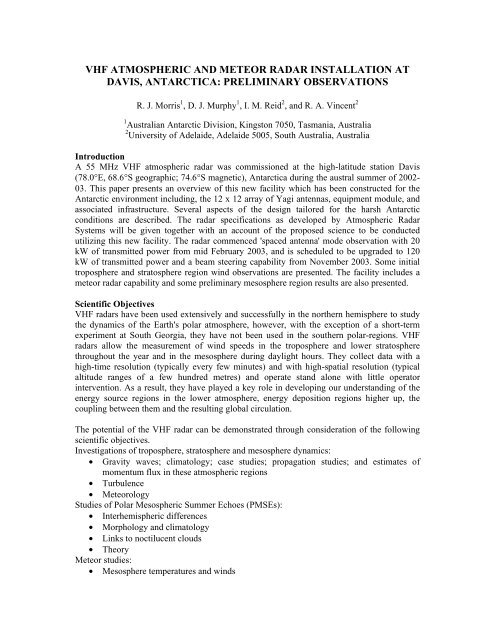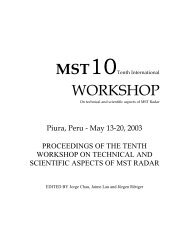vhf atmospheric and meteor radar installation at davis, antarctica
vhf atmospheric and meteor radar installation at davis, antarctica
vhf atmospheric and meteor radar installation at davis, antarctica
- No tags were found...
You also want an ePaper? Increase the reach of your titles
YUMPU automatically turns print PDFs into web optimized ePapers that Google loves.
VHF ATMOSPHERIC AND METEOR RADAR INSTALLATION ATDAVIS, ANTARCTICA: PRELIMINARY OBSERVATIONSR. J. Morris 1 , D. J. Murphy 1 , I. M. Reid 2 , <strong>and</strong> R. A. Vincent 21 Australian Antarctic Division, Kingston 7050, Tasmania, Australia2 University of Adelaide, Adelaide 5005, South Australia, AustraliaIntroductionA 55 MHz VHF <strong><strong>at</strong>mospheric</strong> <strong>radar</strong> was commissioned <strong>at</strong> the high-l<strong>at</strong>itude st<strong>at</strong>ion Davis(78.0°E, 68.6°S geographic; 74.6°S magnetic), Antarctica during the austral summer of 2002-03. This paper presents an overview of this new facility which has been constructed for theAntarctic environment including, the 12 x 12 array of Yagi antennas, equipment module, <strong>and</strong>associ<strong>at</strong>ed infrastructure. Several aspects of the design tailored for the harsh Antarcticconditions are described. The <strong>radar</strong> specific<strong>at</strong>ions as developed by Atmospheric RadarSystems will be given together with an account of the proposed science to be conductedutilizing this new facility. The <strong>radar</strong> commenced 'spaced antenna' mode observ<strong>at</strong>ion with 20kW of transmitted power from mid February 2003, <strong>and</strong> is scheduled to be upgraded to 120kW of transmitted power <strong>and</strong> a beam steering capability from November 2003. Some initialtroposphere <strong>and</strong> str<strong>at</strong>osphere region wind observ<strong>at</strong>ions are presented. The facility includes a<strong>meteor</strong> <strong>radar</strong> capability <strong>and</strong> some preliminary mesosphere region results are also presented.Scientific ObjectivesVHF <strong>radar</strong>s have been used extensively <strong>and</strong> successfully in the northern hemisphere to studythe dynamics of the Earth's polar <strong>at</strong>mosphere, however, with the exception of a short-termexperiment <strong>at</strong> South Georgia, they have not been used in the southern polar-regions. VHF<strong>radar</strong>s allow the measurement of wind speeds in the troposphere <strong>and</strong> lower str<strong>at</strong>ospherethroughout the year <strong>and</strong> in the mesosphere during daylight hours. They collect d<strong>at</strong>a with ahigh-time resolution (typically every few minutes) <strong>and</strong> with high-sp<strong>at</strong>ial resolution (typicalaltitude ranges of a few hundred metres) <strong>and</strong> oper<strong>at</strong>e st<strong>and</strong> alone with little oper<strong>at</strong>orintervention. As a result, they have played a key role in developing our underst<strong>and</strong>ing of theenergy source regions in the lower <strong>at</strong>mosphere, energy deposition regions higher up, thecoupling between them <strong>and</strong> the resulting global circul<strong>at</strong>ion.The potential of the VHF <strong>radar</strong> can be demonstr<strong>at</strong>ed through consider<strong>at</strong>ion of the followingscientific objectives.Investig<strong>at</strong>ions of troposphere, str<strong>at</strong>osphere <strong>and</strong> mesosphere dynamics:• Gravity waves; clim<strong>at</strong>ology; case studies; propag<strong>at</strong>ion studies; <strong>and</strong> estim<strong>at</strong>es ofmomentum flux in these <strong><strong>at</strong>mospheric</strong> regions• Turbulence• MeteorologyStudies of Polar Mesospheric Summer Echoes (PMSEs):• Interhemispheric differences• Morphology <strong>and</strong> clim<strong>at</strong>ology• Links to noctilucent clouds• TheoryMeteor studies:• Mesosphere temper<strong>at</strong>ures <strong>and</strong> winds
A detailed account of the science objectives can be found <strong>at</strong> www.aad.gov.au under AASProject 2325 "VHF <strong>radar</strong> studies of the Antarctic mesosphere, str<strong>at</strong>osphere <strong>and</strong> troposphere"Drs Ray Morris, Damian Murphy, Andrew Klekociuk, Gary Burns, Iain Reid <strong>and</strong> BobVincent.VHF Radar Specific<strong>at</strong>ionsArray dimensions: 42.43 m x 42.43 mAntennas: 3 element Yagi's with a folded dipole driver elementAntenna Grouping: Groups of four adjacent antennas are grouped to form 36 sub-arraysTranceiver: 6 channel fixed frequencyMeteor Capability: The <strong>radar</strong> can be switched to a 5 antenna <strong>meteor</strong> array (with a separ<strong>at</strong>etransmit antenna)Table 1. Description of the Davis VHF Radar.Frequency55 MHzArray12x12 grid of 3-element Yagi antennas 0.7 Lambda spacingEffective Area of Array 2180 m 2 At 55 MHzOne-way beam width ~ 7 degrees Using whole arrayPeak Power 20 kW (2003) 120 kW (2004) In 6 x 20 kW modulesAverage Power 6 kW 5% Duty cyclePower Aperture Product ~1.5 x 10 7 Wm 2 At peak powerFigure 1. A photograph of the Davis VHF <strong>radar</strong> <strong>install<strong>at</strong>ion</strong>.Antenna Array Design <strong>and</strong> ConstructionThe project was assessed under a ‘preliminary environmental assessment’ in compliance withthe Madrid Protocol for Protection of the Antarctic Environment. Final site selection was
ased upon a geotechnical engineering assessment to protect the array from possible damagedue to permafrost <strong>and</strong> annual freeze <strong>and</strong> thaw cycles. The 3-element Yagi antennas th<strong>at</strong> makeup the array were <strong>at</strong>tached to their vertical 50 mm diameter support posts <strong>at</strong> varying heightsabove the ground so as to set the plane of their driver elements horizontal. The posts ranged inlength from 2 to 4 metres. The posts were supported <strong>at</strong> their base by concrete blocks designedto prevent transl<strong>at</strong>ion <strong>and</strong> rot<strong>at</strong>ion. The strain caused by wind loading on the antennas <strong>and</strong>posts was taken up by a system of guy ropes. Concrete blocks were placed on small pads ofun-reinforced concrete approxim<strong>at</strong>ely 800 mm x 800 mm x 250 mm. These provided an evensurface to support the blocks <strong>and</strong> were oversized to allow the block to be moved into thecorrect position on the pad. The guy system consisted of a network of ropes <strong>at</strong> the height ofthe top of the poles. After tensioning, the guy ropes were secured to anchor points <strong>at</strong> the endsof each row <strong>and</strong> column of antennas. After setting each support post to vertical, the top ofeach post was clamped to an East-West <strong>and</strong> a North-South aligned guy. The rope used was a‘braid’ made of fibre th<strong>at</strong> has a high strength <strong>and</strong> a low stretch factor. The <strong>radar</strong> module haspower <strong>and</strong> fibre optics communic<strong>at</strong>ions to the main st<strong>at</strong>ion network.Radar Oper<strong>at</strong>ing Schedule for the 2003 Austral Winter with Preliminary Observ<strong>at</strong>ionsFigure 2. Horizontal windmeasurements in themesosphere <strong>and</strong> lowerthermosphere obtained withthe VHF <strong>radar</strong> oper<strong>at</strong>ing in<strong>meteor</strong> mode.Through the Antarctic winter, the VHF <strong>radar</strong> schedule emphasises detection of <strong>meteor</strong> echoesfrom the mesosphere <strong>and</strong> lower thermosphere. These echoes are to be used, in conjunctionwith other instruments <strong>at</strong> Davis, for wind <strong>and</strong> temper<strong>at</strong>ure comparisons. However, soundingsof the lower <strong>at</strong>mosphere are carried out every 12 minutes. The frequency <strong>and</strong> dur<strong>at</strong>ion oflower <strong><strong>at</strong>mospheric</strong> soundings was l<strong>at</strong>er increased to every 6 minutes for two hour intervalsfollowing ozone-sonde <strong>and</strong> st<strong>and</strong>ard sonde balloon releases.Figure 3. Direction ofarrival for <strong>meteor</strong>detections on 30 April2003 <strong>at</strong> Davis.
Figure 4. Horizontal velocitiesin the troposphere <strong>and</strong> lowerstr<strong>at</strong>osphere obtained using theDavis VHF <strong>radar</strong>. One minutelower <strong>at</strong>mosphere soundings arecarried out <strong>at</strong> 12 minuteintervals.Figure 5. Average echo power<strong>and</strong> signal-to-noise r<strong>at</strong>io fortropospheric soundings usingthe Davis VHF <strong>radar</strong>.Davis St<strong>at</strong>ion Research FacilityThe VHF Radar is loc<strong>at</strong>ed on the shoreline of Heidemann Bay some 2 km from Davis st<strong>at</strong>ion,Antarctica (78.0°E, 68.6°S geographic; 74.6°S magnetic). The Australian Antarctic Division<strong>and</strong> the Australian physics community have developed Davis as their primary site for highl<strong>at</strong>itudemiddle <strong>and</strong> upper <strong><strong>at</strong>mospheric</strong> physics research. Finally, the science objectives will beaddressed using the suite of instruments <strong>at</strong> Davis coupled with intern<strong>at</strong>ional collabor<strong>at</strong>ion.Middle <strong><strong>at</strong>mospheric</strong> experiments include:Rayleigh <strong>and</strong> Doppler lidar; 2 MHz Medium Frequency Spaced Antenna <strong>radar</strong>; Czerny-Turner Spectrometer observing OH airglow; Fast Fourier Transform Spectrometer observingOH airglow; Scanning Radiometer; <strong>and</strong> UV Spectrophotometer.Upper <strong><strong>at</strong>mospheric</strong> experiments include:Fabry-Perot Spectrometer; Digital Portable Sounder; Three Field Photometer; Wide AngleTwo Field Photometer; Fluxg<strong>at</strong>e Magnetometer; Induction Magnetometer; IRIS ImagingRiometer; 30 MHz St<strong>and</strong>ard Riometer; All Sky Video Camera; Ionospheric Scintill<strong>at</strong>ions;Total Electron Content; <strong>and</strong> Magnetic Absolutes.AcknowledgmentsWe acknowledge the support of the Australian N<strong>at</strong>ional Antarctic Research Expeditions (ANARE)expeditioners <strong>at</strong> Davis during the 2002-03 austral summer. The VHF <strong>radar</strong> was installed by Space <strong>and</strong>Atmosphere Science expeditioners – Damian Murphy, Ray Morris, Lloyd Symons, Danny R<strong>at</strong>cliffe<strong>and</strong> Richard Groncki, <strong>and</strong> Trade expeditioners – Paul Saxby, Alan Taylor <strong>and</strong> Chris He<strong>at</strong>h, under thesupervision of Janine Lea. Richard Groncki provided the photograph of the VHF <strong>radar</strong> <strong>at</strong> Davis.
















